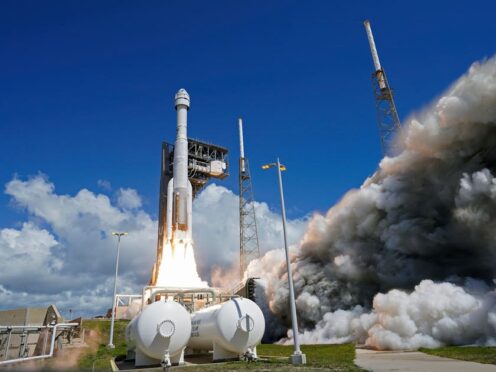
Boeing’s new capsule arrived at the International Space Station on Thursday, delayed by last-minute thruster trouble that almost derailed the docking for this first test flight with astronauts.
The 260-mile-high (420km-high) link-up over the Indian Ocean culminated more than a day of continuing drama for Boeing’s astronaut flight debut carrying Nasa test pilots Butch Wilmore and Suni Williams.
Boeing plans to keep Starliner at the space station for at least eight days before guiding it to a landing in the western US.

“Nice to be attached to the big city in the sky,” Mr Wilmore said once the hooks between the two spacecraft were tight.
The Starliner capsule already had one small helium leak when it rocketed into orbit on Wednesday.
Boeing and Nasa managers were confident they could manage the propulsion system despite the problem and that more leaks were unlikely, but just hours into the flight, two more leaks cropped up.
Later, four of the capsule’s 28 thrusters went down. The astronauts managed to restart three of them, providing enough safety margin to proceed.
By then, Starliner had passed up the first docking opportunity and circled the world for an extra hour alongside the station before moving in.
It was not immediately known whether the thrusters’ problems were related to the earlier leaks.
The leaks pose no safety issues for Nasa test pilots Butch Wilmore and Suni Williams or the mission, Boeing spokesman Jim May said earlier in the day.
Starliner to the stars! ✨
At 10:52am ET, @BoeingSpace #Starliner lifted off on a @ULALaunch Atlas V for the first time with @NASA_Astronauts aboard. This Crew Flight Test aims to certify the spacecraft for routine space travel to and from the @Space_Station. pic.twitter.com/WDQKOrE5B6
— NASA (@NASA) June 5, 2024
Helium is used to pressurise the fuel lines of Starliner’s thrusters, which are essential for manoeuvring.
Before lift-off, engineers devised a plan to work around any additional leaks in the system. A faulty rubber seal no bigger than a shirt button is believed to be responsible for the original leak.
After the space shuttles were retired, Nasa hired Boeing and SpaceX to ferry astronauts to and from the space station.
SpaceX’s taxi service began in 2020, and Boeing was supposed to start around the same time but was held up for years by safety concerns and other troubles.
Boeing’s capsule finally took off from Florida on Wednesday with the Nasa test pilots on board.
The firm plans to keep Starliner at the space station for at least eight days before guiding it to a landing in the western US.

Enjoy the convenience of having The Sunday Post delivered as a digital ePaper straight to your smartphone, tablet or computer.
Subscribe for only £5.49 a month and enjoy all the benefits of the printed paper as a digital replica.
Subscribe